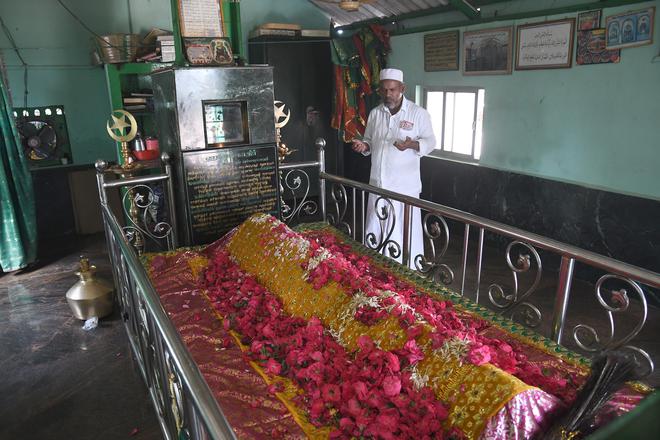
Nearly 350 years and counting, this dargah on the seashore, along the bucolic landscape of the East Coast Road near Chennai, has stood the test of time. It stands witness to natural calamities and ecocide.
Nestled between the sea and the land in Chengalpattu district is the Hazrat Seiyathu Muhamadhu Sha Kathari (Radiya-Allahu Anhu) Dargah, or Nemmeli Dargah, as known among pilgrims and travellers. It has, for years, stood firm in the face of adverse climate events, including the 2004 tsunami, the recent floods, and sea erosion, offering a safe haven to pilgrims traversing kilometres from across the State.
Staying back forever
A large number of pilgrims offer prayers at the dargah, shaded by pine trees. Some of them take a dip in the sea and relax on the beach. A few of them have even stayed back, forever, making it their permanent abode.
Khurshid Begum, who has been frequenting the dargah for years, says the tsunami had only brushed past the structure. “Even with its proximity to the sea, visitors feel safe here, with some of them even taking a dip in the water. The dargah has welcomed pilgrims, irrespective of religion or geography,” she says.
Like the many pilgrims who camp overnight in the open at the dargah, Ms. Khurshid, hailing from a village 60 km from Nemmeli, had camped outdoors, during her several visits to the dargah, with the breeze wafting from the sea. “I often visit the dargah and stay for at least three to four days. It is my place of solace. Every time I am here, I sleep in the open and step out of the premises only for food,” she says.
The dargah, believed to have been established in 1674, is located on about 20 cents of land. It provides the pilgrims with basic facilities, including the equipment required to cook food, as they spend the night in the open: under roofing sheets or in the shade of the trees.
In the recent past, it has witnessed an influx of youngsters and tourists, most of whom come to the dargah for its scenic setting and tranquillity. The dargah registers a surge in visitors at weekends and on holidays. The visitors are a mix of those who are aware of the dargah and its significance, and passing motorists curious to explore, says another frequent visitor.
Special prayers
Every day, Muhammod Yunus, 51, the Sheriff of the dargah, conducts special prayers to ward off “bad luck and negativity”. “We have upheld faith here amid a changing landscape,” Mr. Yunus says. Whoever makes a ziyarat (visit) to the dargah and offers prayers is patted with a jhadhu (broomstick) by him. “We have embraced community living here, offering what we can afford to the pilgrims,” says Mr. Yunus, who has been a part of the dargah for over 20 years.
The mazar that washed ashore
Legend holds that Hazrat Seiyathu Muhamadhu Sha Kathari appeared in the dream of an individual from a settlement in the locality about 350 years ago. A few days later, while taking a stroll along the shore, the person stumbled on the mazar (mausoleum) of Hazrat Seiyathu Kathari that had washed ashore. It is believed that overwhelmed by the manifestation, he went on to look after the mausoleum, housing it in a small structure established near the shore itself. However, there is no record of the occurrence.
The settlement witnessed an unprecedented growth over the years, and the people of the settlement attributed their good fortune to the mazar on the shore. “They took care of the structure, with each generation contributing to its maintenance and development,” says Mr. Yunus.
Power supply issue
The dargah relies on a generator for power supply. “We tried to get an electricity connection but ran into hurdles for several reasons,” he says, pointing to the remoteness of the place and an ongoing land dispute. “This dargah was established many years ago. Yet, several issues, including land disputes, plague it,” he says. “We have been putting up with these challenges, and manage to provide basic facilities to whoever visits the dargah,” he says, adding that a chirag (lamp) always shines bright inside the shrine.
“The dargah at Kovalam, about 10 km away, is well known. This is a lesser-known one. Yet, tourists turn up here, most of whom are aware of its significance,” says Mr. Yunus.
According to him, among the visitors is acclaimed musician A.R. Rahman, most notably during the period before the release of Roja.
Boon and bane
Concerns have been brewing over the possibility of the dargah land coming under the expansion plan of the recently inaugurated desalination plant at Nemmeli. The peculiar location of the dargah has both been a boon and a bane, says Rasool, a pilgrim, highlighting the “peace of mind the dargah provides to pilgrims”. “I have seen familiar faces revisiting the dargah. Those heading further south make a stopover at the dargah that treats everyone with equal respect,” says a visitor.







